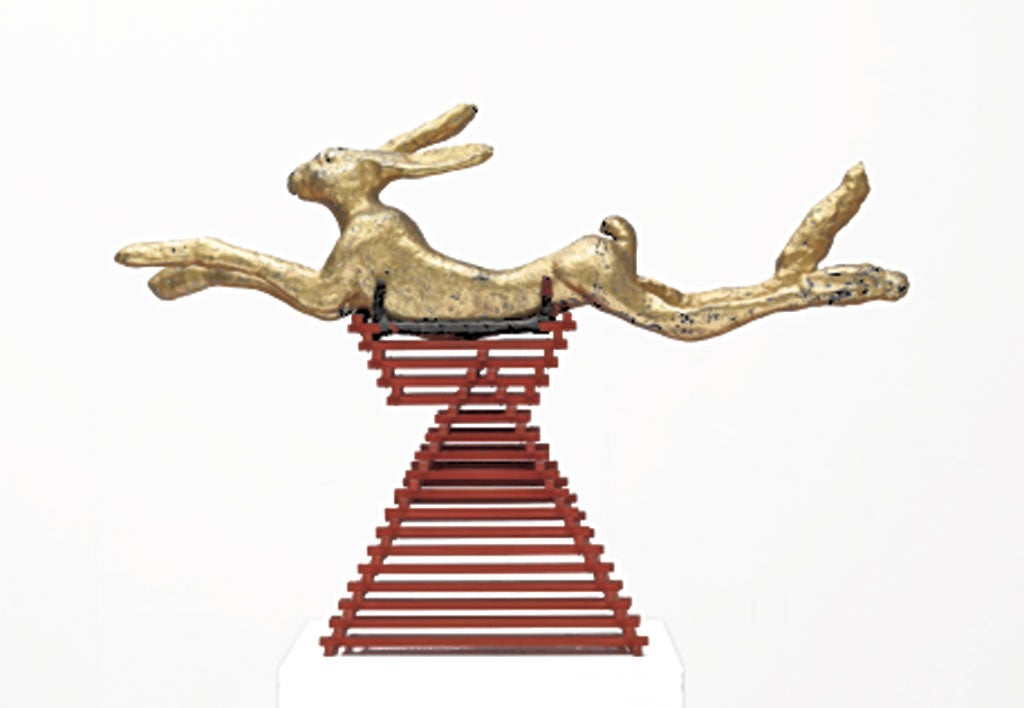Barry Flanagan: Early Works 1965-82, Tate Britain, London

Was there a Barry Flanagan before he became far too besotted by the motif of the hare (and its enduring mythological and symbolic significance) for his own good? Oh yes, and this interesting exhibition of his early work, which ends just at the point where the hare leaps centre-stage, gives us a good glimpse of that playful maker.
The young Flanagan of the middle 1960s was in tune with the gleefully anarchic absurdist humour of Alfred Jarry, the creator of Ubu Roi and much else, and Jarry's liberating presence is everywhere in this show. So many of the titles of individual works are Jarry-esque: aaing j gni aa or pdreeoo, for example. The last describes a slightly deflated, pumpkin-like thing. What captures our attention from first to last is how anti-monumental so much of this work aspires to be. There is nothing here that climbs towards the heroic, nothing which proudly rears up and proclaims: I am sculpture. I am here forever. No, this is more anti-sculpture than sculpture.
Flanagan is all about process and experimentation, coaxing things into being part-way, and then letting go in order to see what happens. He creates strange non-things from unconventional materials – rope, hessian, sand. His sculptures, loose and sloppy in shape, loll or sag about the floor or find themselves stacked up in corners. He makes sculptures out of folded blankets, trussed up bags. Sculpture should not consist of enduring forms, these works seem to be saying. We are self-created. We could just have easily been something else. We are constantly subject to the whims and the winds of chance.
He creates a tettering ziggurat out of colourful, wormy sausage shapes. He hangs fragile wooden tepees with ragged pennons. He pinions a huge, sagging hessian canvas against a wall with the aid of wooden props. All so laughably provisional, you might say.
Even when he begin to carve into stone, that sense of the playful and the accidental remains. He raises up stone monoliths on dubious plinths. He stacks and inscribes on stones in ways that both elevate them and simultaneously destroys any belief that that these objects might exist to be worshipped or venerated. A lovely piece called Ubu of Arabia (1976) is highly characteristic. This piece consists of a stacking of lumps of Hornton stone. The topmost stone traps a fragment of canvas beneath it, which makes the piece look like a cross between Paddington Bear and a neolithic goddess. We feel that Flanagan was striving to achieve just that level of ambiguity.
Throughout this show, we feel that Flanagan is asking himself the same questions over and over again: what is it about sculpture that deserves to be taken seriously? How and why does it speak to us? To what extent is the transaction between the thing made and the onlooker a social one? Everything is fluid, all his solutions are in the making. Nothing comes to rest, nothing is resolved. Until, following an encounter with a book called The Leaping Hare, he found an image outside of himself that at last seemed to embody enduring values and enduring meanings. His restless nature became tamed – and so did his art.
This exhibition brassily shows off the pleasure-giving unruliness of his youth.
To 2 January (020 7887 8888)
Join our commenting forum
Join thought-provoking conversations, follow other Independent readers and see their replies
Comments
Bookmark popover
Removed from bookmarks